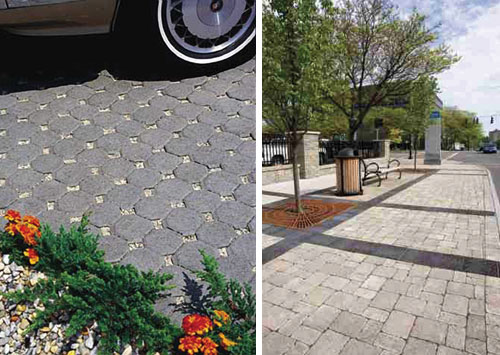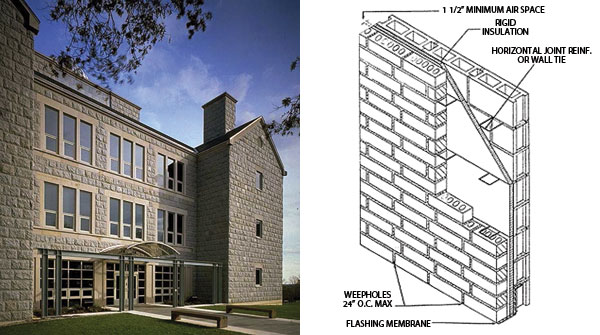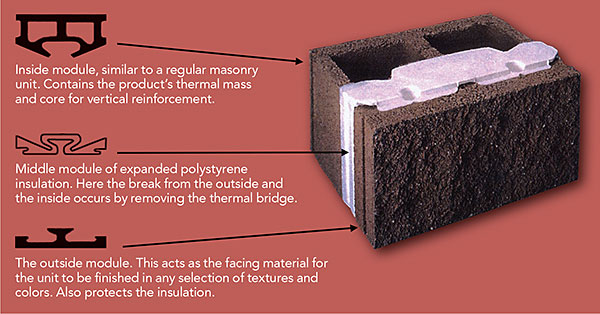Concrete Masonry in Green Buildings
Sustainable Sites Using CMUs
The focus of this category of green building design is on enhancing the positive aspects of a building site while minimizing the negative impacts that adding a building can have on that site and the surrounding area. Generally, there are three areas that concrete masonry can help achieve this overall goal for sustainable sites:
Development DensityProviding denser buildings with smaller footprints has been demonstrated to be an important part of sustainable and walkable communities. The fire resistance capability of concrete masonry directly enables greater building density by meeting fire code requirements for separation of spaces. Further, the structural attributes of CMUs allow for vertical building design that can help minimize building footprints. In particular the modular aspect of concrete masonry lends itself to working well within small or irregular shaped building lots as easily as larger ones. In terms of optimizing the most appropriate use of a site, it is worth noting that segmented retaining walls (SRW) made of concrete masonry has the potential to allow for the utilization of sites previously considered to be unsuitable due to slope or irregular terrain. In all, creating denser clusters of buildings can be coupled with a high ratio of open space that promotes biodiversity and effective environmental site design.
Community ConnectivityThe modular nature of concrete masonry is actually quite optimal for dense sites that are short on space but high on pedestrian or vehicular traffic. The use of concrete masonry pavers of different types and styles introduces a design element that helps weave a particular building or series of buildings into the community fabric it is located within. This can be an attractive and effective way to create pedestrian access between the project site and neighborhood buildings and services.
Stormwater ManagementIn the interest of reducing disruption to natural hydrology patterns and minimizing the potential for pollution due to stormwater runoff, permeable paving has emerged as a very effective strategy. CMU pavers that are non-pervious and allow stormwater to permeate between them are not only effective in this regard, they provide an attractive aesthetic with a variety of colors and textures compared to monolithic paving choices such as asphalt or concrete. By properly specifying and designing with CMU site pavers, green building objectives can be met by reducing impervious ground covering thus increasing on-site infiltration and reducing stormwater runoff. From a general design standpoint, this approach can also increase the usable space on a site while requiring very little maintenance. For more detailed information on this strategy, designers can consult the National Concrete Masonry Association (NCMA) technical bulletin titled “NCMA TEK 11-11: Permeable Pavements for Commercial Parking Lots.” Open grid paving systems are also recognized as reducing heat island effects and can thus provide this additional benefit as described further below.
 |
Permeable CMU site pavers allow stormwater to penetrate into the soil, thus avoiding unwanted run off, reducing pollution, and reducing the heat island effect. Photos courtesy of Oldcastle® Architectural |
Developed areas are known to have higher air temperatures than non-developed areas due in large part to the presence of dark-colored surfaces that produce heat when the sun shines on them. This phenomenon is referred to as a “heat island” and can notably affect the localized microclimate, producing an unwanted warming effect on people and buildings. As such, strategies to reduce this generated heat focus on either shading dark surfaces or providing hardscape surfaces that reflect rather than absorb sunlight to keep temperatures cooler. The unit of measurement for a material to be effective in reducing the heat island effect is the solar reflectance index (SRI). Based on a scale of 1 to 100 per standard ASTM procedures, a score of 0 would apply to a standard black surface (highly non-reflective) while a score of 100 would apply to a white surface (very reflective). The green building standard is to achieve a minimum SRI of 29 across hardscape materials. Happily, typical new gray CMU pavers have been tested at an SRI of 35 thus exceeding the minimum benchmark by over 20 percent.
By using a combination of these CMU-based strategies in sustainable site design, designers can readily achieve a substantial number of points under the LEED rating system toward an overall green building certification level.
Energy and Atmosphere Contributions from CMUs
Optimizing energy performance is what most people think of when they think green buildings. In all cases, the LEED rating system now requires some minimum performance levels to be achieved and offers the greatest number of potential points under this critical category. Using CMUs as part of an overall building envelope and construction strategy can contribute to over half of the available points here, but more importantly can dramatically reduce energy costs and the carbon footprint associated with a building in various ways.
Optimize Energy Performance through Continuous Insulation
The place where architects spend a lot of time addressing energy conservation is in the building envelope and specifically in how to effectively insulate the envelope from thermal heat loss or unwanted heat gain. It has become increasingly recognized in energy codes and standards as well as in LEED that insulation is most effective at achieving thermal performance results when it is truly continuous and not interrupted by framing or structural members thus avoiding energy-draining thermal bridges. Stud space insulation installed only between studs or other structural members dramatically decreases the effective insulation R-values of walls well below the intended design level. Conversely, it has been common for CMU cavity wall construction to place insulation between the layers or wythes of masonry such that the insulation is truly continuous and uninterrupted by any other structural members. This means that the full value of the insulation is available without compromise other than needed fasteners and intended openings, which of course need to be properly detailed. Further, the amount of insulation installed can vary based on a particular building's needs and the climate it is located in thus seeking to optimize the performance of the wall. And since this is such a common practice, different modular products and insulation approaches are available. Some innovative approaches have even gone beyond the common cavity wall approach creating multi-part CMU systems that include an inner and outer CMU module with a middle piece of rigid insulation, which stops thermal breaks and contributes to overall energy performance.
 |
Typical cavity wall concrete masonry construction with continuous rigid insulation Images courtesy of Oldcastle® Architectural |
 |
Some innovative CMU products provide multi-part units with a full thermal break avoiding thermal bridging. Images courtesy of Oldcastle® Architectural |









